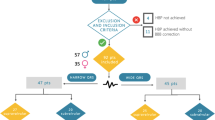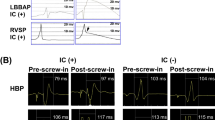Abstract
Background
Leadless pacemakers are an effective treatment for bradycardia. However, some cases exhibit pericardial effusions, presumably associated with device implantations on the right ventricular free-wall. The present study was carried out to find the ECG features during ventricular pacing with a Micra, which enabled distinguishing free-wall implantations from septal implantations without using imaging modalities.
Methods
Thirty-one consecutive patients who received Micra implantations in our facility were enrolled. The location of the device in the right ventricle was evaluated using echocardiography or computed tomography in order to determine whether the device was implanted on the septum (Sep group), apex (Apex group), or free-wall (FW group). The differences in the 12-lead ECG during ventricular pacing by the Micra were analyzed between the Sep and FW groups.
Results
The body of the Micra was clearly identifiable in 22 patients. The location of the device was classified into Sep in 12 patients, Apex in 4, and FW in 6. The mean age was highest in the FW and lowest in the Sep group (82.7 ± 6.6 vs. 72.8 ± 8.7 years, p = 0.027). The peak deflection index (PDI) was significantly larger in the FW group than Sep/Apex group in lead V1 (Sep: 0.505 ± 0.010, Apex: 0.402 ± 0.052, FW: 0.617 ± 0.043, p = 0.004) and lead V2 (Sep: 0.450 ± 0.066, Apex: 0.409 ± 0.037, FW: 0.521 ± 0.030, p = 0.011), whereas there was no difference in the QRS duration, transitional zone, and QRS notching.
Conclusion
The PDI in V1 could be useful for predicting implantations of Micra devices on the free-wall and may potentially stratify the risk of postprocedural pericardial effusions.



Similar content being viewed by others
References
Baddour LM, Epstein AE, Erickson CC, Knight BP, Levison ME, Lockhart PB, et al. Circulation. 2010;121:458–77.
Olsen T, Jorgensen OD, Nielsen JC, Thogersen AM, Philbert BT, Johansen JB. Incidence of device-related infection in 97 750 patients: clinical data from the complete Danish device-cohort (1982-2018). Eur Heart J. 2019;40:1862–9.
Reddy VY, Exner DV, Cantillon DJ, Doshi R, Bunch TJ, Tomassoni GF, et al. Percutaneous implantation of an entirely Intracardiac leadless pacemaker. N Engl J Med. 2015;373:1125–35.
Reynolds D, Duray GZ, Omar R, Soejima K, Neuzil P, Zhang S, et al. A leadless Intracardiac Transcatheter pacing system. N Engl J Med. 2016;374:533–41.
Roberts PR, Clementy N, Al Samadi F, Garweg C, Martinez-Sande JL, Iacopino S, et al. A leadless pacemaker in the real-world setting: the Micra Transcatheter pacing system post-approval registry. Heart Rhythm. 2017;14:1375–9.
Hai JJ, Fang J, Tam CC, Wong CK, Un KC, Siu CW, et al. Safety and feasibility of a midseptal implantation technique of a leadless pacemaker. Heart Rhythm. 2019;16:896–902.
McGavigan AD, Roberts-Thomson KC, Hillock RJ, Stevenson IH, Mond HG. Right ventricular outflow tract pacing: radiographic and electrocardiographic correlates of lead position. Pacing Clin Electrophysiol. 2006;29:1063–8.
Pang BJ, Joshi SB, Lui EH, Tacey MA, Ling LH, Alison J, et al. Validation of conventional fluoroscopic and ECG criteria for right ventricular pacemaker lead position using cardiac computed tomography. Pacing Clin Electrophysiol. 2014;37:495–504.
van Oosterom A, Oostendorp TF. ECGSIM: an interactive tool for studying the genesis of QRST waveforms. Heart. 2004;90:165–8.
R Core Team [2018]. R: a language and environment for statistical computing. R Foundation for Statistical Computing, Vienna. URL https://www.R-project.org/
Hachiya H, Hirao K, Sasaki T, Higuchi K, Hayashi T, Tanaka Y, et al. Novel ECG predictor of difficult cases of outflow tract ventricular tachycardia: peak deflection index on an inferior lead. Circ J. 2010;74:256–61.
Liaw A, Wiener M. Classification and regression by randomForest. R News. 2002;2(3):18–22.
El-Chami MF, Roberts PR, Kypta A, Omdahl P, Bonner MD, Kowal RC, et al. How to implant a leadless pacemaker with a tine-based fixation. J Cardiovasc Electrophysiol. 2016;27:1495–501.
Ritter P, Duray GZ, Steinwender C, Soejima K, Omar R, Mont L, et al. Early performance of a miniaturized leadless cardiac pacemaker: the Micra Transcatheter Pacing Study. Eur Heart J. 2015;36:2510–9.
Piccini JP, Stromberg K, Jackson KP, Laager V, Duray GZ, El-Chami M, et al. Long-term outcomes in leadless Micra transcatheter pacemakers with elevated thresholds at implantation: Results from the Micra Transcatheter Pacing System Global Clinical Trial. Heart Rhythm. 2017;14:685–91.
Acknowledgements
We thank Mr. John Martin for his linguistic assistance in the preparation of this manuscript.
Author information
Authors and Affiliations
Corresponding author
Ethics declarations
Conflict of interest
All authors declare no conflict of interest related to this study.
Additional information
Publisher’s note
Springer Nature remains neutral with regard to jurisdictional claims in published maps and institutional affiliations.
Rights and permissions
About this article
Cite this article
Kajiyama, T., Kondo, Y., Nakano, M. et al. Peak deflection index as a predictor of a free-wall implantation of contemporary leadless pacemakers. J Interv Card Electrophysiol 60, 239–245 (2021). https://doi.org/10.1007/s10840-020-00724-y
Received:
Accepted:
Published:
Issue Date:
DOI: https://doi.org/10.1007/s10840-020-00724-y




